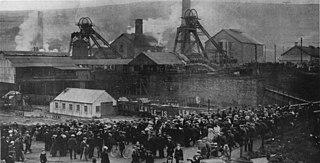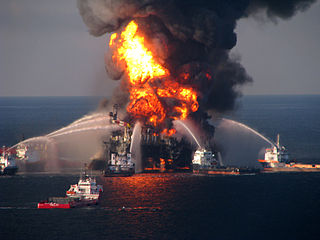The 2010 Zonguldak mine disaster occurred in Zonguldak Province, Turkey, on May 17, when 30 miners died in a firedamp explosion at the Karadon coal mine.
The mine is operated by the state-owned Turkish Coal Corporation (Türkiye Taşkömürü Kurumu, TTK). On May 20, 2010, rescuers retrieved the bodies of 28 workers; [1] the bodies of two more were only recovered eight months later. [2] This was the third mining disaster in Turkey in six months: 19 miners were killed in December 2009 in a methane gas explosion in Bursa Province, and in February 2010, 13 miners died after an explosion in a mine in Balıkesir Province. [1]
According to statistics collected by the General Mine Workers Union (Genel Maden İşçileri Sendikası) of Turkey, 25,655 accidents occurred in Turkish Coal Corporation mines during the preceding ten years (2000–2009), in which over 26,000 mine workers were injured, and 63 lost their lives. [3] According to statistics by the Chamber of Mining Engineers (Maden Mühendisleri Odası) of Turkey, a total of 135 miners were killed in mining accidents in general in the years 2008 and 2009. [4]
Prime Minister Erdoğan, visiting the site of Zonguldak in 2010 after the accident, declared that the "people of this region are used to incidents like this", which are "the fate [ Turkish : kader] of this profession", while calling protests against the unsafe working conditions in the state mines a "provocation". [5]
Several other mining disasters have occurred in Turkey’s mines:

Zonguldak Province is a province along the western Black Sea coast region of Turkey. The province is 3.481 km2 in size and has a population of 619,703. Its adjacent provinces are Düzce to the southwest, Bolu to the south, Karabük to the southeast, and Bartın to the east. The capital is Zonguldak. Its Governor is Erdoğan Bektaş.
Firedamp is any flammable gas found in coal mines, typically coalbed methane. It is particularly found in areas where the coal is bituminous. The gas accumulates in pockets in the coal and adjacent strata and when they are penetrated the release can trigger explosions. Historically, if such a pocket was highly pressurized, it was termed a "bag of foulness".
A mining accident is an accident that occurs during the process of mining minerals or metals. Thousands of miners die from mining accidents each year, especially from underground coal mining, although accidents also occur in hard rock mining. Coal mining is considered much more hazardous than hard rock mining due to flat-lying rock strata, generally incompetent rock, the presence of methane gas, and coal dust. Most of the deaths these days occur in developing countries, and rural parts of developed countries where safety measures are not practiced as fully. A mining disaster is an incident where there are five or more fatalities.

The Senghenydd colliery disaster, also known as the Senghenydd explosion, occurred at the Universal Colliery in Senghenydd, near Caerphilly, Glamorgan, Wales, on 14 October 1913. The explosion, which killed 439 miners and a rescuer, is the worst mining accident in the United Kingdom. Universal Colliery, on the South Wales Coalfield, extracted steam coal, which was much in demand. Some of the region's coal seams contained high quantities of firedamp, a highly explosive gas consisting of methane and hydrogen.

The Oaks Colliery explosion was a British mining disaster which occurred on 12 December 1866, killing 361 miners and rescuers at the Oaks Colliery at Hoyle Mill near Stairfoot in Barnsley, West Riding of Yorkshire. The disaster centred upon a series of explosions caused by firedamp, which ripped through the underground workings. It is the worst mining accident in England and the second worst mining disaster in the United Kingdom, after the Senghenydd colliery disaster in Wales.
The Minnie Pit disaster was a coal mining accident that took place on 12 January 1918 in Halmer End, Staffordshire, in which 155 men and boys died. The disaster, which was caused by an explosion due to firedamp, is the worst ever recorded in the North Staffordshire Coalfield. An official investigation never established what caused the ignition of flammable gases in the pit.

The Drummond Mine explosion, also called the Drummond Colliery Disaster, was a mining accident that happened in Westville, Pictou County, Nova Scotia on May 13, 1873.

Energy resources bring with them great social and economic promise, providing financial growth for communities and energy services for local economies. However, the infrastructure which delivers energy services can break down in an energy accident, sometimes causing considerable damage. Energy fatalities can occur, and with many systems deaths will happen often, even when the systems are working as intended.

On 13 May 2014, blasting at Eynez coal mine in Soma, Manisa, Turkey, caused an underground mine fire, which burned until 15 May. In total, 301 people were killed in what was the worst mine disaster in Turkey's history. The mine, operated by coal producer Soma Kömür İşletmeleri A.Ş., suffered a fire, the causes of which were later found to be complex. The fire occurred at the mine's shift change, and 787 workers were underground at the time. At the time the disaster was thought to be mainly an explosion rather than fire. After the final bodies were pulled from the mine on 17 May 2014, four days after the fire, the Minister of Energy and Natural Resources Taner Yıldız confirmed the number of dead was 301. Disaster and Emergency Management Presidency (AFAD) announced the names of 301 workers who died in the mine disaster and 486 people who survived.
Soma Kömür İşletmeleri A.Ş. is a Turkish coal mining company with headquarters in Istanbul, and one of the largest coal producers in the region. As of 2014, it had 5,500 employees and mined 2.5 million tons of coal annually, according to its website. It owns the mine involved in the Soma mine disaster, in which at least 301 people were killed.
The following lists events in the year 2013 in Turkey.

Hatice Beril Dedeoğlu was a Turkish academic who served as the Minister of European Union Affairs in the interim election government led by Prime Minister Ahmet Davutoğlu between 22 September and 17 November 2015. Having taken over from the previous interim cabinet minister Ali Haydar Konca following his resignation, Dedeoğlu served until Davutoğlu formed a new government after the November 2015 snap general election. She was, as required by the Constitution, of no political affiliation and was one of two women to serve in the interim cabinet, the other being Family and Social Policy Minister Ayşen Gürcan.

In February 2016, a series of explosions caused the deaths of 36 people, including 31 miners and five rescue workers, at the Severnaya coal mine 10 kilometres north of the city of Vorkuta, Komi Republic, Russia. The explosions were believed to be caused by ignition of leaking methane gas. It is the second deadliest mining disaster of the 2010s behind the Soma mine disaster, and fourth deadliest of the 21st century thus far.

The Lundhill Colliery explosion was a coal mining accident which took place on 19 February 1857 in Wombwell, Yorkshire, UK in which 189 men and boys aged between 10 and 59 died. It is one of the biggest industrial disasters in the country's history and it was caused by a firedamp explosion. It was the first disaster to appear on the front page of the Illustrated London News.

Coal supplies over a quarter of Turkey's primary energy. The heavily subsidised coal industry generates over a third of the country's electricity and emits a third of Turkey's greenhouse gases.
The 1923 Bellbird Mining Disaster took place on 1 September 1923 when there was a fire at Hetton-Bellbird coal mine, known locally as the Bellbird Colliery or mine. The coal mine was located near the village of Bellbird, which is itself three miles southwest of Cessnock in the Northern coalfields of New South Wales, Australia. The accident occurred in the No. 1 Workings of the mine and resulted in the deaths of 21 miners and their horses. Subsequently there was a thorough investigation into the causes of the accident which resulted in legislative changes that were implemented in an effort to improve worker safety in Australian coal mines. These efforts culminated with the Mines Rescue Act 1925 which established standards for mine rescue operations in New South Wales (NSW) province. At the time of the disaster the mine employed 538 people including 369 who worked underground. The accident killed 21 miners and caused legislation changes.

The Luisenthal mine disaster was the most serious mine accident in the history of the Federal Republic of Germany. The explosion killed 299 miners.

On 14 October 2022, an explosion occurred in Amasra coal mine in Amasra, Bartın Province, Turkey, killing 41 people and injuring 11. It was one of the deadliest industrial incidents in Turkey.